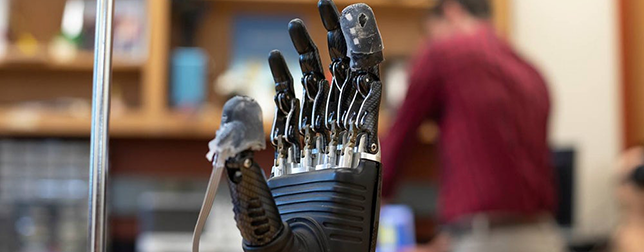Researchers at Johns Hopkins have developed an electronic skin (“e-dermis”) that could be implemented to a prosthetic hand to enable the wearer have a feel of touch.
Sense of touch or pain are some of the most hoped-for features for prosthetic devices. The fine mechanics and dexterity achieved in a robotic had cannot be used to its fullest functionality if the wearer doesn’t feel what they’re touching. Prosthetics still do not provide the wearer a ton of feedback about what they’re touching – no temperatures, no textures.
Read more Restoring Movement Sensation in Patients with Upper Limb Amputation
When placed over a prosthetic device, this artificial skin lets an amputee feel pain and other sensations in their missing limb.
The electronic skin is made of a soft material and rubber seeded with the touch sensors that can actually reproduce the activity of nerve endings. It can be wrapped around the fingertips of existing prostheses.
Researchers explored the human skin in order to create the electronic skin that functions like human skin. A network of sensors located in our skin relays various sensations to the brain, telling us if we’re touching something that is hot or cold, sharp or smooth, soft or hard, and so on.
The skin they created is aimed at transmitting two specific sensations: the sharpness and curvature of an object. They used a combination of fabric and rubber to make the skin. Layers of sensors were added to copy the receptors in human skin. These sensors could perceive the sensations of an item – whether it is even or uneven, for example – and then relay those sensations to the peripheral nerves in an amputee’s residual limb via wires.
The research team used a technique called transcutaneous electrical nerve stimulation (TENS) to stimulate the peripheral nerves in the amputee’s residual limb and question what they felt in their phantom limb. If a specific level of TENS at one location on the residual limb generated a sensation of pain in the amputee’s phantom thumb, the researchers would know to send that level of stimulation to the area when the prosthetic’s thumb touched something comparably painful, like a pointed object. EEG (electroencephalography) was used to detect brain activity, confirming the process stimulated the phantom limb.
Read more Using Machine Learning Algorithm to Personalize Wearables
Essentially, the e-dermis was taught to electronically encode different sensations similar to what human skin does.
The researchers believe the electronic skin could provide prosthetics a more life-like feel while protecting them from damage.
They are now planning on trying to improve the sensing ability of the e-dermis by making it feel temperature of an object.
The study was published in the journal Science Robotics.













